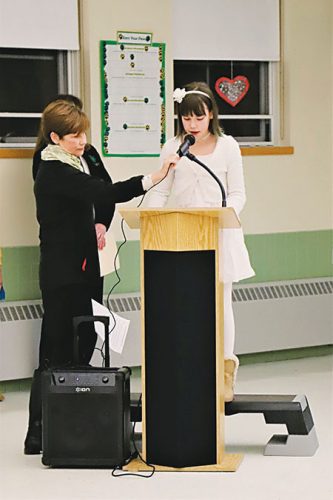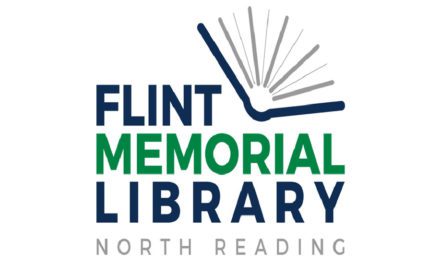Published February 6, 2020

FOURTH-GRADER Elizabeth Ayer told the School Committee about a project she did on Canada during the committee’s visit to the Batchelder School. Assisting her at the podium is fourth-grade teacher Annie Hewitt. (Jillian String Photo)
By JILLIAN STRING
NORTH READING — Project Based Learning (PBL) was at the forefront of the Batchelder School’s presentation to the School Committee on January 27. Principal Sean Killeen, along with Batchelder students and staff, hosted the committee for their regularly scheduled meeting.
“Tonight is one of those nights we always look forward to. We appreciate you getting out of your routine and taking a little time to come to the schools and get to meet with our students and learn a little bit of what they’re doing at the elementary school level,” Killeen said.
Second-grade teachers Jennifer Berry and Katherine Fay assisted their students in presenting PBL projects to the committee.
“Recently, all four second-grade classes completed a cross curricular research project about landforms,” Berry said.
Second-graders Taylor Boutwell, Lukas Schomp, Taylor Rosenfield, and Colin Hannan explained the project to the committee.
“In Digital Learning, we completed a project about landforms. We learned a bit about the different types of landforms in science from our unit on pebbles, sand, and silt. Then, we each got to choose a different landform to learn more about,” Boutwell said.
According to Schomp, each student filled out an organizer and conducted research using computers in Digital Learning class. The second-grade teachers assisted students in creating paragraphs from the collected research back in the classroom.
“First, we needed to come up with an introduction. That’s the part where you learn what the piece is all about,” Rosenfield said. “After that, we worked on the body of our piece.”
Hannan stated that the students took the completed paragraphs back to Digital Learning and used an app called Seesaw to put the project together.
Digital Learning specialist Chris Lindsay played a few clips from the final Seesaw projects. One project depicted glaciers and the other discussed islands.
School Committee Chairman Scott Buckley asked the students what their favorite fact about glaciers was.
“I like how a glacier is formed, because it’s kind of a cool process how the melted snowflakes freeze and layer up,” Schomp said.
Fourth-grade teachers Kathleen Bythrow and Annie Hewitt, along with students Gargi Bhosle, Sebastian Garvin, and Elizabeth Ayer, were next to the podium to share their HyperDoc Social Studies Project.

TAYLOR BOUTWELL (at far right) explains the second-grade project-based learning assignment on landforms at a recent School Committee meeting. Front row, from left: second-grade teacher Jennifer Berry and second-graders Colin Hannan, Taylor Rosenfield, Lukas Schomp and Boutwell. Behind them is second-grade teacher Katherine Fay. (Jillian String Photo)
“We are very happy, along with our students, to show you some new curriculum that we created this year, due to some new Social Studies standards we have in fourth-grade,” Hewitt said. “This evening, we’re going to feature some student research as well, where they had to do some analysis and then a presentation on Canada and Mexico.”
According to Hewitt, Lindsay taught the fourth grade team about building and using HyperDocs, which according to Google, is a term used to describe a Google Doc that contains an innovative lesson for students. Using a shortened link, students can access lessons containing links, instructions, and other tasks.
“First we saw short videos introducing Canada and Mexico using our Chromebooks. Then we took some time to preview each country using online databases and textbooks,” Garvin said.
Bhosle stated that once the students chose which country they wanted to focus upon, they explained their decisions using an app called Padlet.
“My Padlet says, ‘I’d like to do Canada because I think more people speak English. I’d also like to do Canada because it has Niagara Falls and it has so many beautiful animals, many islands, and nature is my thing,’” Ayer said.
Garvin noted that students chose a state from Mexico or a province from Canada to study in more depth.
Bhosle added that the class created a slideshow of all the information to share with the entire class.

BATCHELDER SCHOOL Student Council members informed the School Committee of their work with Lazarus House during the committee’s visit to their school last week. From left: Sebastian Garvin, Vivianna Fortin, Staff Advisor Kristina Petrie, Kelvin Ma, and Bryce Sharp. (Jillian String Photo)
Ayer noted that each student also completed a video reflection on their experiences completing the project.
“With this project, the students were able to take increased responsibility for their topic, research, and learning. They had ownership of the decision-making along the way, were actively engaged, and were able to work at their own pace,” Bythrow said. “As teachers, we’re able to differentiate the amount of support the students needed.”
School Committee Vice Chairman Janene Imbriano commended the students and teachers on their hard work.
“I’m just astounded,” Imbriano said.
New Student Council introduced
School psychologist Kristina Petrie and the members of the Student Council concluded the evening with a discussion about council events and how to become a member.
“It is an honor to introduce to you the fourth- and fifth-grade students, as not only members (of the Student Council), but also as our future leaders,” Petrie said.
According to fifth-grader Norah Denninger, the Student Council organizes fundraisers and events to help various programs and organizations.
Fourth-grader Izabella Sarcia stated that the group is currently working with Lazarus House.
“The Lazarus House is a welcoming place to donate supplies to others in need,” fifth-grader Kelvin Ma said.
The council will be collecting clean, gently used clothing to donate to Lazarus House.
Fourth-graders Bhosle, Harry Agganis, and Rami El-Sheikh stated that the council will be focusing on the character trait of leadership this month.
“Being a leader is being respectful,” Agganis said.
Fourth-grade members of the council include Agganis, Bhosle, Laurel Cappella, El-Sheikh, Garvin, Avery Hajj, Sarcia, and Bryce Sharp.
Fifth-grade members include Alyssa Butler, Deninger, Vivianna Fortin, Ma, Megan Rogers, and Cara Ward.
Killeen noted that this is the first Student Council at the Batchelder School, and the group is modeled after the Hood School Student Council run by Sadie Sherman and Whitney Cleary, who have both been assisting Petrie and Beth Weiss with council logistics.
School Committee member Rich McGowan asked how students were chosen to be part of the council.
“We go before school or after school and we fill out an application and then five random teachers, we don’t know who they are, they pick their top five and then they all agree on their favorites,” Cappella said.
Imbriano asked how the number of students was determined, and Petrie stated that two students from each fourth- and fifth-grade class were chosen in order to have a “fair representation of student ideas.”
“One nice thing about these presentations is that we see what different schools are doing, so it’s nice when we see one school likes something another school does and they kind of incorporate it,” Buckley said.




